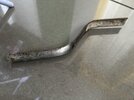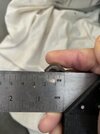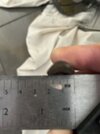- Joined
- 2 Dec 2004
- Messages
- 600
- Reaction score
- 4
- Country

Pointing is supposed to be dug out to about 20mm. Spreading new stuff over the surface is a waste of time and will drop off later. And looks ****.
You need to cut it well back and get a good depth over it, not like that photo you showed where it looks like the pointing had been painted on.
Yeah that wasn't done by me, it was done before I bought the house either by the previous owner or before that maybe. The survey didn't mention it and I didn't pick it up on the viewing.
When I did my sections I raked out at least an inch and cleaned up all the edges. Some parts I had to go a lot deeper as the old mortar just fell out like sand falling through your fingers.
Plastering sand is a fine sharp, as is silver sand which is a very fine sharp sand.
Building sand looks the same as the photos of yours when the laitance has weathered back. It's not all fine grains. A well graded building sand contains a mixture of sizes. A rule of thumb is that the largest grains should be no more than 1/3 of the joint size. The coarse sharp sand you get from the merchants has a grain size too large for most brick joints. I use it for repointing stonework with much larger joints, usually mixed with Building sand to make it more workable.
Lots of DIYers put up photos of weathered mortar joints which show larger grains thinking it's a coarse sharp sand. That type of sand would be really difficult to build a brick wall with.
So is it worth buying a bag of each of these sands and experimenting with different proportions to see what colours they produce?



